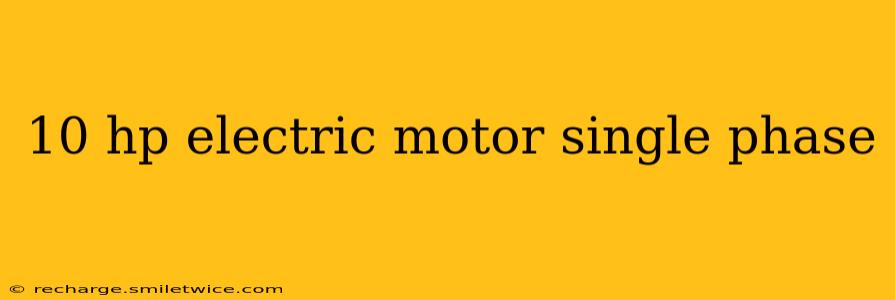Finding the right electric motor for your needs can be challenging, especially when dealing with higher horsepower ratings like 10 HP. Single-phase 10 HP electric motors are less common than their three-phase counterparts, but they are available and suitable for specific applications. This guide will delve into the specifics of these motors, answering common questions and offering valuable insights.
What are the Applications of a 10 HP Single-Phase Electric Motor?
10 HP single-phase motors are typically used in applications requiring substantial power but where three-phase power isn't readily available. These applications often involve heavier-duty tasks that demand significant torque. Some examples include:
- Heavy-duty pumps: Large water pumps for irrigation or industrial processes.
- Compressors: Air compressors for various industrial uses, such as powering pneumatic tools.
- Conveyors: Moving heavy materials in industrial settings.
- Large woodworking machinery: Certain types of woodworking equipment, such as large planers or jointers.
- Agricultural equipment: Specific agricultural machinery might utilize a 10 HP single-phase motor where three-phase power isn't accessible.
Are 10 HP Single-Phase Motors More Expensive Than Three-Phase Motors?
Generally, yes. 10 HP single-phase motors are usually more expensive than comparable three-phase motors of the same power rating. This is because single-phase motors require more complex internal components to achieve the same power output as a three-phase motor. The added complexity in design and manufacturing contributes to the higher cost.
What are the Advantages and Disadvantages of Using a 10 HP Single-Phase Motor?
Advantages:
- Ease of installation: Single-phase power is readily available in most homes and smaller businesses, simplifying installation.
- Suitable for specific applications: Ideal for locations lacking three-phase power.
Disadvantages:
- Higher cost: As previously mentioned, they tend to be more expensive than three-phase alternatives.
- Lower efficiency: Single-phase motors are generally less efficient than three-phase motors, leading to higher energy consumption.
- Limited availability: Compared to three-phase motors, 10 HP single-phase motors might be harder to find from various suppliers.
- Higher starting current: They often draw significantly higher current upon startup, potentially requiring specialized wiring and circuit protection.
What Type of Capacitor is Needed for a 10 HP Single-Phase Motor?
The capacitor requirements for a 10 HP single-phase motor vary greatly depending on the specific motor design and its intended application. Some motors might employ a permanent capacitor, while others might utilize a run capacitor or even a combination of run and start capacitors. It is crucial to consult the motor's nameplate or the manufacturer's specifications to determine the exact capacitor type, rating, and connection details. Using an incorrect capacitor can damage the motor.
How Do I Choose the Right 10 HP Single-Phase Motor for My Needs?
Selecting the correct 10 HP single-phase motor necessitates considering several factors:
- Voltage: Ensure the motor's voltage rating matches your power supply.
- Full-load current: Verify that your electrical system can handle the motor's full-load current.
- Duty cycle: Consider the motor's intended usage and select one with an appropriate duty cycle (continuous, intermittent, etc.).
- Enclosure type: Choose an enclosure type that suits the environment where the motor will operate (e.g., open, enclosed, explosion-proof).
- Mounting: Select a mounting type that is compatible with your equipment.
- Speed: Consider the required speed of the motor for your application.
What are the Safety Precautions When Using a 10 HP Single-Phase Motor?
High-power motors present safety risks. Always adhere to these precautions:
- Proper electrical grounding: Ensure the motor is correctly grounded to prevent electrical shocks.
- Overload protection: Use an appropriate overload relay or circuit breaker to prevent damage from excessive current draw.
- Lockout/Tagout procedures: Follow proper lockout/tagout procedures before performing any maintenance or repairs.
- Proper ventilation: Ensure adequate ventilation around the motor to prevent overheating.
- Qualified personnel: Installation and maintenance should be performed by qualified electricians and technicians.
This guide provides a comprehensive overview of 10 HP single-phase electric motors. Remember, always consult with a qualified electrician or motor specialist to ensure you select and install the appropriate motor for your specific application and to ensure safe operation. Ignoring these safety considerations can lead to serious injury or equipment damage.
